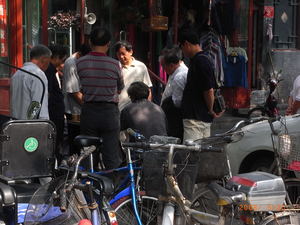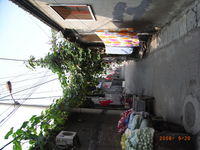Peking just after the Olympics (impressions from my trip)
I visited Beijing from September 18-20 and met a couple of Chinese scholars. My intention was to ascertain China’s post-Olympic diplomatic orientation and see if there was any change in its attitude toward Russia since the recent war in Georgia. I arrived there just when the US government announced a plan to buy out bad loans, but the people I met in China were relatively calm. I will refrain from describing technical details here and instead focus on expressing the impression that I got from this visit.
Taxis in China were known for overcharging, but that practice is now history. Meter rates became the norm a few years ago, and printed receipts can also be requested. I no longer see taxi solicitors crowding airport exits either, which used to be at once an annoyance and a convenience. That may be a slight setback as I now have no choice but to wait in line at the taxi stand.
As the car approached the city, my companion, who last visited Beijing six months ago, exclaimed, “Everything has changed in the space of just six months. I can’t even tell where I am now!”
What we saw was a city in transition. Bicycles and motorcycles were sharing the same streets, and donkey carts, which reportedly made up the traffic two or three years ago, were nowhere to be seen. Sidewalks were frequented by simply clad people, but they were dressed in a variety of fashions. When I first visited Beijing three decades ago, they all wore the same Mao suit. Tiananmen Square looked rather empty back then, and if memory serves, there had been a public restroom at the corner that was less than accommodating.
But China has now grown into a major economy. For postwar baby-boomers like us, it is like we have suddenly discovered a superpower next door. To be honest, such a thing was not even imaginable.
The city center showcased a lineup of neat high-rise buildings. It was a magnificent sight. However that is only one side of the picture. A little off the center, I could see littered spaces and shabby shops squeezed among new apartment buildings. When I further ventured into an eatery at the outskirts of the city, I saw a back alley lighted by dim red lanterns, leading to dining rooms and corridors. Toilets there are not very clean, to say the least.
Such scenes reminded me of the backstreets of Moscow and Tashkent rather than Tokyo. It was a distinctly familiar feeling. At its historical turning points, China has occasionally opted to adopt foreign cultures. Right now it is absorbing European and American cultures, but a little while ago it looked to the Soviet Union as its model. The legacy of Soviet culture can still be seen elsewhere, though not even local Chinese recognize them as such nowadays as almost two decades have passed since the collapse of the communist regime in Russia. I tried to take snapshots of them from the car to no avail. As I grabbed the old-fashioned handle to lower the window, the poorly constructed piece came off and I missed the chance.
Across Qianmen, I saw a replica of a 19th-century street that was readied for the Olympics. Although many of the shops were not yet open, the place was bustling with tourists from within the country. It was like a movie set, fit for staging a spaghetti western, or you might say, a noodle western.
So I quickly left Qianmen Street and headed right for an alley called hutong, which reveals the face of old-time Beijing. There was a distinct nostalgic air -- and smell -- which reminded me of my old hometown. Such scenes were once common in Japan, and I almost felt as if I could hear the sounds of tofu sellers. Many of the residents there were old people, laid back with placid expressions.
From there I took a taxi toward Beihai Park which hosted a large artificial lake. Beijing was founded under the Liao Dynasty, and was later reworked and expanded by the Mongolian ruler Kublai Khan. A canal was constructed around that time to connect Beijing and Guangzhou, complemented by an artificial lake to harbor ships carrying rich products from the south. The vast steppe nearby must have supported herds of Mongolian warhorses, acting as one major depot for chariots. The present-day building complex nearby called Zhongnanhai was reportedly founded during the Ming Era.

(Peking people playing shogi)
At the corner of the lake was an artificial islet known as Qiónghuá Island. A stupa (mound-like tower serving as a Buddhist shrine) known as Bai Ta (White Dagoba) was built by the Qing emperor during the late seventeenth century. Qing was an empire of federative character composed of the Manchu, Mongol, Tibetan and Han ethnic groups. Tibet was a major force at that time, ruling the Xīnjiāng region as well as its own territory, which became a part of Chinese territory only after Tibet joined the Qing Empire. Therefore, as a sign of respect to Buddhist Tibet, the Qing emperor built Bai Ta in a religiously crucial location north of the Forbidden Palace.
I had once read in a guidebook that a statue of the Fifth Dalai Lama was placed at the bottom of the tower. I always wanted to confirm that, but this turned out to be a frustrating task. My companion asked around for its whereabouts, to little avail: “I know no such place,” “The place is closed” were their responses. Even when we sighted a likely temple on the hillside and asked a saleswoman at the souvenir shop, we got no better response. I don’t think that was intentional. I suppose they really did not know, despite for the fact that much of their revenues came from the temple.
Finally, one man told us, “Go up the mound. You can find it in the third temple.” So we started hiking. I cannot recall what was in the first temple. The second temple housed a Chinese-style Maitreya statue, which looked very much different from those in Korea or Japan. The Maitreya I am familiar with is a gaunt figure, but the one I saw in China exhibited enormous presence, much like Budai. I felt like I was looking at a contrast of the spiritualism of Korea and Japan versus the pragmatism of China.
We then came to the third temple. At first we could not identify the figure of the Dalai Lama inside. There seemed to be only three Buddha statues. But looking closely at the display, it was revealed that the statue at the center was the founder of Lamaism, flanked by the Panchen Lama at the left and the Fifth Dalai Lama at the right. I was imagining a sole Dalai Lama statue sitting at the recess of a somber hall, but the reality was completely different.
Dalai Lamas were supposedly chosen by revelation. Prominent Lama monks searched villages for a brilliant boy fit to be the next Dalai Lama, whom they should find “in accordance to a revelation.” However, the reality in the Middle Ages was not that straightforward. Which family would produce the next Dalai Lama was an issue of the greatest interest for Tibetan aristocrats. What they called “revelation” must have been the result of their secret intrigue. The Tibetan court was rife with internal rivalries back in the Middle Ages, and a number of Dalai Lamas were prematurely assassinated. Later, the Qing Dynasty, which initially treated Tibet as an ally, started intervening in this “personal affair.” At the end, the permission from the Qing court became the norm for the succession of the Dalai Lama. On the other hand, this indicates the profound influence possessed by the Dalai Lama.
I dropped by the adjacent Jingshan Park, where I saw a group of elementary school students engaged in making sketches. They seemed not much older than ten, but their sketches were very mature, exhibiting professional-like precision. Given that they were born under the one-child policy, I suppose they single-handedly shoulder all the hopes of their parents and grandparents -- not to mention the responsibility to look after them. I guess that explains their prowess in both sports and arts. They are not spoiled at all. No wonder Japanese athletes fall behind them in the Olympic Games. These Chinese youths acquire incredible competitiveness, repeatedly tested from an early age.
Before boarding my flight back home, I saw an Indian man, a Japanese woman, and a young Japanese man enjoying a conversation in an airport cafe, all speaking Japanese, as if they had known each other for a long time. I was not expecting to hear a Japanese conversation with an Indian in China: an interesting mixture indeed. Outside the window I saw jets taking off, which were quickly absorbed into the smog-clouded sky -- or perhaps it might be the work of the ancient yellow dust.
It only takes a little more than three hours from Beijing to Narita. The reverse route takes a bit longer, about five hours as it traverses the Korean Peninsula. But the proximity does not necessarily mean that Japan is the outskirts of China. Just look at the UK, France and Germany: they are so distinct, not only in languages but in mindsets as well.
Trackbacks
TrackBack URL for this entry:
http://www.japan-world-trends.com/cgi-bin/mtja/mt-tb.cgi/555
![Japan-World Trends [English]](/images/logo.gif)

Comment
Thanks again for the blog post.Really looking forward to read more.
You are my function models. Many thanks for your post
pretty practical material, overall I think this is worthy of a bookmark, thanks
You can definitely see your expertise in the work you write.
You definitely know how to bring an issue to light and make it important. I cant believe youre not more popular because you definitely have the gift.
wow, awesome blog.Really looking forward to read more. Fantastic.